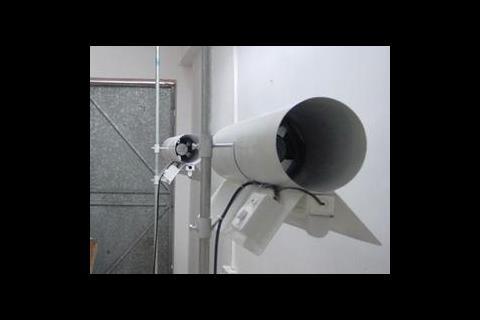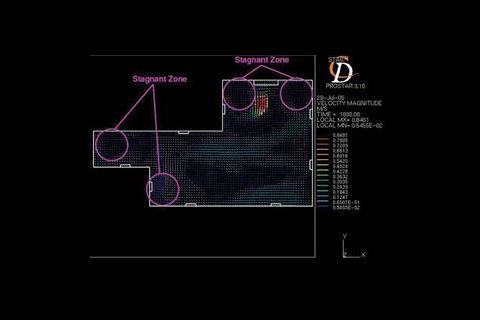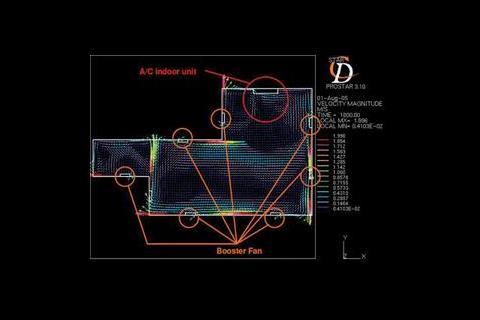Concerned that energy-saving proposals could leave the city's residents hot under the collar, a team set out to research its thermal comfort zones.
It may be hard to get your head around this in the tail end of a British winter, but try, if you will, to imagine a hot, humid Hong Kong summer. Why? Because the Hong Kong government is suggesting that the region's summertime air-conditioned apartment room temperature for apartments is set at 25.58C to save energy.
This could save the region an estimated HK$1 billion of electricity for every 18C rise of air-conditioned room temperature. The government admits 25.58C might not be everyone's preferred temperature, but it is high enough to save a substantial amount of cooling energy. The obvious question is whether this is acceptable or not, so we decided to look at the effect raising the temperature has on comfort and investigate ways to improve this.
Most Hong Kong citizens live in small flats set in tall residential buildings of 10 to 40-storeys within urban districts. Air-conditioning is a must-have in almost every flat and in most cases, the units are installed either in windows or in the building's facade. The problem is that air distribution from these units is not good and cooled air is rarely distributed everywhere in a room. Living rooms, in particular, tend to suffer from poor air distribution because they are rectangular, with a high length-to-width ratio - so further away from the window unit, the room temperature is high and there is no discernable air movement.
To get around this, residents often set the thermostat control of these units either to a very cold setting or even "continuous operation" - and at the same time, the fan speed is set to "high". This practice uses a tremendous amount of energy.
In order to tackle these problems, we need to design forced ventilation and air-conditioning systems for residential flats based on the "human comfort" concept instead of the conventional "rule-of-thumb" approach.
Thermal comfort
One way to estimate "human comfort" is by means of Predicted Mean Vote (PMV), which is based on the thermal comfort equation introduced by Professor Fanger in 1970 and takes into account six parameters: human metabolic rate, clothing, dry-bulb temperature, water vapour pressure/humidity, radiant temperature and speed of air movement.
The authors strongly advise that if the temperature setting is increased to 25.58C and nothing else is changed, nobody can work efficiently inside the office during summer in Hong Kong. In other words, in order to comply with the recommendations by the HK Government, something has to be done to guarantee an appropriate indoor PMV, or comfort factor.
In February 2005, CIBSE awarded a grant to research comfort temperatures in the region and we commenced an investigation soon afterwards.
Outdoor humidity is normally constant during Hong Kong summers, so citizens are used to high humidity; and radiation isn't usually a problem because Venetian blinds or semi-transparent curtains are commonly used. Our study, therefore, focused on dry-bulb temperature and air movement.
We rented a typical residential flat in downtown Dongguan City (about 90 km north-west of Hong Kong), as it was difficult to find a residential flat in Hong Kong. The flat's layout is shown in Figure 1.
The experiment was carried out in summer, when both outdoor temperature and humidity are high. Three split-type air-conditioners were installed: a larger unit for the living area and smaller ones for each bedroom. The condensers were installed on the flat's balcony.
The usual way to increase air movement, and hence comfort, is by using fans. But modern architects and homeowners are not keen on fans from an interior design perspective. To get around this, the team designed a new kind of fan, called the "fan-lamp" - a 150 mm diameter, 30 W fan placed inside a cylinder and integrated with a 25 W wall-lamp. The fans create air movement everywhere in the room and help distribute cool air from the evaporator.
For this to work, the fan-lamps need careful positioning so computational fluid dynamic-based simulation was undertaken to find out the best position and orientation for the fan-lamps. Three different scenarios were modeled: airflow distribution at the living/dining room, with doors of two bedrooms closed; airflow distribution inside one bedroom, and airflow distribution in the living room and bedrooms with all bedroom doors opened.
PMV in practice
Finally, in order to find out the best PMV ranges for building occupants, we conducted a simple survey, using just six male and female subjects from three age groups.
The results of this survey (see Table 1), show that when the PMV is close to zero, all the subjects feel cold and cool. The most comfortable range for them was between 0.5 and 1. When additional resources are available, a more comprehensive survey should be carried out in the region.
We tried many fan location scenarios, only some of which are described here. One scenario had eight fan-lamps placed at a level about 2 m from the ground and along the walls of the living room. Figure 2 shows the result of CFD simulation when all fan/lamps were switched off and only the air-conditioner was turned on - the long rectangle represents the evaporator and the fan lamps are shown as small rectangles.
As Figure 2 shows, there were four stagnant zones, about 1.5 m above ground, in at least four regions in the living room. In these zones, even if the temperature was low enough, the comfort level would still be very poor.
To ensure the comfort level in these zones was acceptable, the temperature setting of the air-conditioner had to be adjusted to its lowest value, which meant the unit's electrical consumption was exceptionally high. Even outside the stagnant zones, the air speed in this room was quite low at 0.3 m/s so the PMV distribution within the room would not be satisfactory.
Another scenario was based on the same configuration, but with all eight fan/lamps operating at 2 m/s alongside the evaporator. Figure 3 shows the airflow distribution under this scenario. Under this mode, the stagnant regions were minimized and the region with low air speed is focused at the centre of the room, where occupants wouldn't normally stay for long.
The most important finding from this research was that it's possible to achieve a comfortable internal environment with the air-conditioning set to 258C.
Confirmation
To prove this, we modelled the room under "normal" conditions. First, all eight fan-lamps serving the living room were turned off. Then the air-conditioner was turned on and set to 178C. At this time, the outdoor temperature was around 328C and the relative humidity about 80%. We measured the PMV at seven pre-selected locations inside the living/dining room, and the energy consumption of every element for a period of 30 minutes. Table 2 (below) shows the results: the PMV at all seven locations were close to zero, while the energy consumption was 1.2 kWh.
Next, the temperature setting of the air-conditioner was adjusted to 258C and all eight fan-lamps were switched on. As Table 3 (below) shows, the PMV values were a little higher than the previous results. However, the energy consumption of everything during the 30-minute period was down to 0.41 kWh. Therefore, the energy consumption was only 34% of the value when the temperature was set at 178C.
With limited time and resources, we were able to demonstrate that a room temperature of 25.58C, as supported by the Hong Kong Government, can provide an acceptable PMV at the same time as saving a substantial amount of energy. However, an indoor temperature setting of 25.58C can only be acceptable when people dress appropriately and the room air speed is increased or the relative humidity reduced.
What must be controlled is the PMV distribution within a room instead of the dry bulb temperature itself. By using the fan/lamp approach, we have shown that energy saving can be achieved while the PMV value can still be acceptable.
We estimate that, with our proposed method, if every residential apartment saves 10% of its electricity, the city of Hong Kong could save 1,400 MW.
The researchers would like to acknowledge the support given by KO Yeung and Dr Raymond Yau of Ove Arup and Partners HK Limited; Prof KS Li of Dongguan University of Technology, and David Hughes and Julian Amey of CIBSE.
Downloads
FIGURE 1: Layout of the flat in Dongguan
Other, Size 0 kb
Source
Building Sustainable Design
























No comments yet